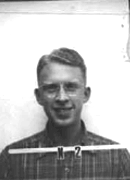Donald Francis Mastick was an American chemist who worked at Los Alamos and on Tinian as part of Project Alberta.
Mastick received his B.S. in Chemistry from the University of California, Berkeley, in 1942. One of Berkeley’s most promising chemistry students, Mastick was recruited to join the Manhattan Project by J. Robert Oppenheimer. Mastick arrived in Los Alamos in the spring of 1943. In the chemistry division, Mastick was tasked with studying the reactions of plutonium. At that time, plutonium was only available in very small amounts, and so this work was done on a small scale under a microscope.
Mastick is perhaps best known for an accident that occurred while he was working in Los Alamos. On August 1, 1944, Mastick accidentally swallowed a small amount of plutonium when the vial he was using exploded in the laboratory. Afterwards, Mastick was tasked with recovering the plutonium he had ingested.
Mastick was later assigned to analyzing urine samples. He requested a transfer, and Oppenheimer sent him along with a group assembling on Tinian, an island that served as the base of operations for the bombing of Japan. As a member of Project Alberta, Mastick served as Assistant Test Director and Operations Officer, helping to deliver the components of the nuclear bombs to Tinian and arm the two nuclear bombs before the Hiroshima and Nagasaki missions.
After the war, Mastick also assisted in the nuclear tests at the Bikini Atoll. After getting his Ph.D. at the University of California, Berkeley, in 1950, Mastick worked in radiochemical research at the U.S. Naval Radiological Defense Lab. Mastick joined the Atomic Energy Commission in 1951, where he served as a scientific advisor and manager of the Division of Military Applications. After serving in a number of other industrial research positions, Mastick started an interior landscape company with his wife.
Mastick died on September 8, 2007, at the age of 87.





